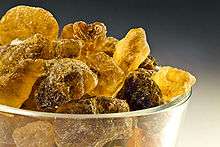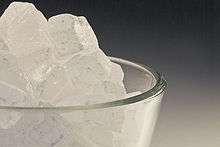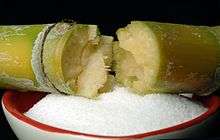Rock candy
|
Colored and flavored rock candy commonly sold in the United States | |
| Alternative names | Rock sugar |
|---|---|
| Type | Confectionery |
| Place of origin | Persia |
| Main ingredients | Sugar, water |
| Other information | 450-225 |
|
| |


Rock candy (also called rock sugar) is a type of confection composed of relatively large sugar crystals. This candy is formed by allowing a supersaturated solution of sugar and water to crystallize onto a surface suitable for crystal nucleation, such as a string, stick, or plain granulated sugar. Heating the water before adding the sugar allows more sugar to dissolve thus producing larger crystals. Crystals form after 6–7 days. Food coloring may be added to the mixture to produce colored candy.
Origins
Candied sugar has its origins in Iran. Islamic writers in the first half of the 9th century described the production of candy sugar, where crystals were grown as a result of cooling supersaturated sugar solutions. In order to accelerate crystallization, confectioners later learned to immerse small twigs in the solution for the crystals to grow on. The sugar solution was colored with cochineal and indigo and scented with ambergris or flower essence.
The name comes from the medieval era, and in turn lends its name to a British candy called rock.[1]
Cuisine
Rock candy is often dissolved in tea. It is an important part of the tea culture of East Frisia, where a lump of rock sugar is placed at the bottom of the cup. Rock candy consumed with tea is also the most common and popular way of drinking tea in Iran. In Iran it is called nabat, and the most popular nabat is saffron.[2]
In China, it is used to sweeten Chrysanthemum tea as well as Cantonese dessert soups and the liquor baijiu. In some Chinese provinces, it is used as a part of traditional Chinese medicine. It is a common ingredient in Chinese cooking, and many households have rock candy available to marinate meats and add to stir fry. Rock candy is also regarded as having medicinal properties and is used to prepare food such as yao shan. In less modern times, rock sugar was a luxury only for the wealthy.
Rock candy is a common ingredient in Tamil cuisine, particularly in the Sri Lankan city of Jaffna.
In the Friesland province of the Netherlands, bits of rock candy are baked in the luxury white bread Fryske Sûkerbôle.
In Mexico it is used during the Day of the Dead to make sugar skulls, often highly decorated. Sugar skulls are given to children so that they will not fear death; they are also offered to the dead.
In the US, rock candy comes in many colors and flavors, and is slightly hard to find, due to it being considered old fashioned.[1]
Misri
|
Misri crystals | |
| Type | Rock candy or sweetener |
|---|---|
| Place of origin | India and Persia |
|
| |
Misri (Urdu: مسری, Hindi: मिश्री) refers to crystallized sugar lumps, and a type of confectionery mineral, which has its origins in India and Persia, also known as rock sugar elsewhere.[3] It is used in India as a type of candy, or used to sweeten milk or tea.[4][5]
In Hinduism, mishri may be offered to a deity as bhog and distributed as prasad. The god Krishna is said to be fond of makkhan (butter) and misri. In many devotional songs written in Brajbhoomi in praise of Krishna, the words makkhan and misri are often used in combination. In Northern Karnataka people serve mishri along with water to visitors in the Summer season.
Among Indian misri dishes are mishri-mawa (kalakand),[6] mishri-peda, which are more commonly eaten in Northern-Western India, Uttar Pradesh, Delhi, Rajasthan, Gujarat, Punjab, Orissa, North coastal of Andhra Pradesh and many other states and parts of India.
The Ghantewala Halwai of Delhi, who started his career by selling Misari mawa in 1790[7] is famous for Misarimawa and sells forty varieties of sweets made from Misari.
Beverages
Rock and rye is a term used both for alcoholic liqueurs and cocktails using rye whiskey and rock candy, as well as for non-alcoholic beverages made in imitation thereof, such as the "Rock & Rye" flavor of soda pop made by Faygo.[8][9]
See also
- Jaggery, an early form of sugar
References
- 1 2 Richardson, Tim. (2002) Sweets: A History of Candy. Bloomsbury. ISBN 978-1582342290 p. 90
- ↑ http://www.mypersiancorner.com/2013/04/sweet-tea-persian-style.html
- ↑ Glossary: Misri Tarla Dalal website.
- ↑ Bashir Ahmad Dar (January 1996). Studies in Muslim philosophy and literature. Iqbal Academy Pakistan. p. 168. Retrieved 9 August 2011.
- ↑ Baden Henry Baden-Powell (1868). Hand-book of the economic products of the Punjab: with a combined index and glossary of technical vernacular words. Printed at the Thomason Civil Engineering College Press. pp. 307–. Retrieved 9 August 2011.
- ↑ Kalakand. chezshuchi.com
- ↑ Hardy's Encyclopaedic Guide to Agra, Delhi, Jaipur, and Varanasi. Hardy & Ally (India). 1970.
- ↑ Jan 13, 2015 (2015-01-13). "This is How to Bring Rock and Rye Back from the Dead". Liquor.com. Retrieved 2016-04-15.
- ↑ Lawrence L. Rouch (2003). The Vernor's Story: From Gnomes to Now. University of Michigan Press. pp. 34–. ISBN 0-472-06697-8.
Further reading
- Saiyid Muhammad Hadi (1902). The sugar industry of the United Provinces of Agra and Oudh. Printed by F. Luker at the Government Press. Retrieved 9 August 2011.
External links
| Look up rock candy in Wiktionary, the free dictionary. |
| Wikimedia Commons has media related to Rock candy. |
- Exploratorium.edu Recipe for rock candy as an educational exercise in crystal and candy making.


